
The vaquero is a horse-mounted livestock herder of a tradition that has its roots in the Iberian Peninsula and extensively developed in Mexico from a methodology brought to the Americas from Spain. The vaquero became the foundation for the North American cowboy, in Northern Mexico, Southwestern United States, and Western Canada.
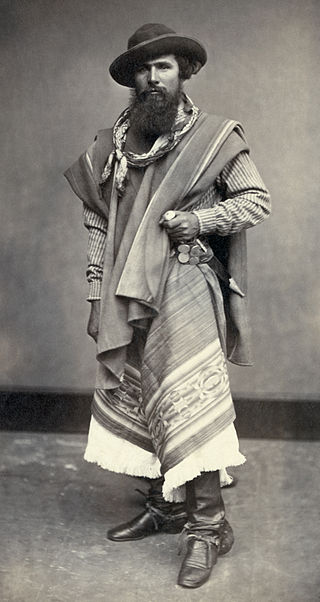
A gaucho or gaúcho is a skilled horseman, reputed to be brave and unruly. The figure of the gaucho is a folk symbol of Argentina, Uruguay, Rio Grande do Sul in Brazil, the southern part of Bolivia, and the south of Chilean Patagonia. Gauchos became greatly admired and renowned in legend, folklore, and literature and became an important part of their regional cultural tradition. Beginning late in the 19th century, after the heyday of the gauchos, they were celebrated by South American writers.

A lasso or lazo, also called in Mexico reata and la reata, and in the United States riata or lariat, is a loop of rope designed as a restraint to be thrown around a target and tightened when pulled. It is a well-known tool of the Mexican and South American cowboys, then adopted, from the Mexicans, by the cowboys of the United States. The word is also a verb; to lasso is to throw the loop of rope around something.

A llanero is a South American herder. The name is taken from the Llanos grasslands occupying eastern Colombia and western-central Venezuela.
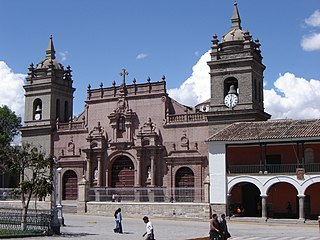
Ayacucho, founded in 1540 as San Juan de la Frontera de Huamanga and known simply as Huamanga until 1825, is the capital city of Ayacucho Region and of Huamanga Province, Ayacucho Region, Peru.

Huayno is a genre of popular Andean music and dance. It is especially common in Peru, Western Bolivia, Northern Argentina and Northern Chile, and is practiced by a variety of ethnic groups, especially the Quechua people. The history of Huayno dates back to colonial Peru as a combination of traditional rural folk music and popular urban dance music. High-pitched vocals are accompanied by a variety of instruments, including quena (flute), harp, siku (panpipe), accordion, saxophone, charango, lute, violin, guitar, and mandolin. Some elements of huayno originate in the music of the pre-Columbian Andes, especially on the territory of the former Inca Empire. Huayno utilizes a distinctive rhythm in which the first beat is stressed and followed by two short beats.

A huaso is a Chilean countryman and skilled horseman, similar to the American cowboy, the Mexican charro, the gaucho of Argentina, Uruguay and Rio Grande Do Sul, and the Australian stockman. A female huaso is called a huasa, although the term china is far more commonly used for his wife or sweetheart, whose dress can be seen in cueca dancing. Huasos are found all over Central and Southern Chile while the Aysén and Magallanes Region sheep raisers are gauchos. The major difference between the huaso and the gaucho is that huasos are involved in farming as well as cattle herding.
José is a predominantly Spanish and Portuguese form of the given name Joseph. While spelled alike, this name is pronounced very differently in each of the two languages: Spanish ; Portuguese.

Quechua people or Quichua people may refer to any of the indigenous peoples of South America who speak the Quechua languages, which originated among the Indigenous people of Peru. Although most Quechua speakers are native to Peru, there are some significant populations in Ecuador, Bolivia, Chile, Colombia, and Argentina.

The Battle of Ayacucho was a decisive military encounter during the Peruvian War of Independence. This battle secured the independence of Peru and ensured independence for the rest of South America. In Peru it is considered the end of the Spanish American wars of independence in this country, although the campaign of Antonio José de Sucre continued through 1825 in Upper Peru and the siege of the fortresses Chiloé and Callao eventually ended in 1826.
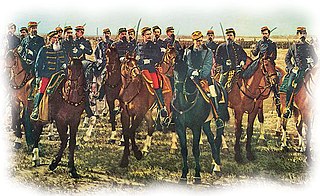
The Conquest of the Desert was an Argentine military campaign directed mainly by General Julio Argentino Roca during the 1870s and 1880s with the intention of establishing dominance over Patagonia, inhabited primarily by indigenous peoples. The Conquest of the Desert extended Argentine territories into Patagonia and ended Chilean expansion in the region.

The Crossing of the Andes was one of the most important feats in the Argentine and Chilean wars of independence, in which a combined army of Argentine soldiers and Chilean exiles invaded Chile crossing the Andes range separating Argentina from Chile, leading to Chile's liberation from Spanish rule.
The term Peruvian literature not only refers to literature produced in the independent Republic of Peru, but also to literature produced in the Viceroyalty of Peru during the country's colonial period, and to oral artistic forms created by diverse ethnic groups that existed in the area during the prehispanic period, such as the Quechua, the Aymara and the Chanka South American native groups.

The Regiment of Mounted Grenadiers "General San Martín" is the name of two Argentine Army regiments of two different time periods: a historic regiment that operated from 1812 to 1826, and a modern cavalry unit that was organized in 1903.
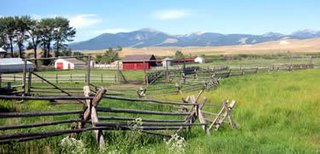
A ranch is an area of land, including various structures, given primarily to ranching, the practice of raising grazing livestock such as cattle and sheep. It is a subtype of farm. These terms are most often applied to livestock-raising operations in Mexico, the Western United States and Western Canada, though there are ranches in other areas. People who own or operate a ranch are called ranchers, cattlemen, or stockgrowers. Ranching is also a method used to raise less common livestock such as horses, elk, American bison, ostrich, emu, and alpaca.

Juan Antonio Álvarez de Arenales was an Argentine general of Spanish origin that fought in the war for the United Provinces of the Río de la Plata, Chile and Peru.
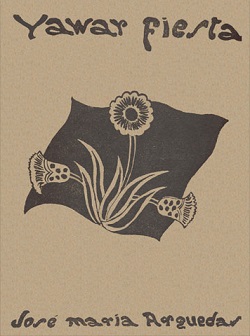
Yawar Fiesta is the first novel by the Peruvian author José María Arguedas, published in 1941. It is considered as part of the Latin-American indigenista movement. Set in the village of Puquio it depicts the performance of a bullfight in the Andean style (turupukllay) as part of a celebration called 'yawar punchay'. According to critics, it is the most successful of Arguedas' novels, from a formal point of view. The author's effort is appreciated for offering the most authentic version possible of Andean life, without resorting to convention or the paternalism of previous indigenous literature.

The Fox From Up Above and the Fox From Down Below is the sixth and final novel by Peruvian writer José María Arguedas published posthumously in 1971. It is an unfinished novel, interspersed with some personal and intimate diaries where the author relates the torments overwhelming him while writing the novel, finally announcing his impending suicide. Complementing the work are two letters and an epilogue. The novel depicts the consequences of accelerated modernization of the port of Chimbote, motivated by the fishing boom; thousands of Andean immigrants arrive, attracted by the opportunity to earn a living in a thriving industrial city, while at the same time they assimilate themselves under the guise of 'modernity', all of which, from the point of the writer, brings dire consequences: loss of Andean cultural identity and its moral degeneracy, succumbing to the vices of the city in bars and brothels.

















